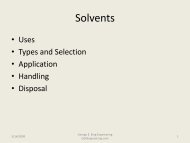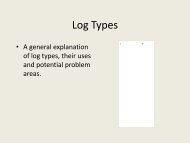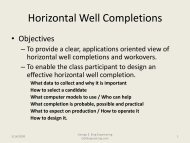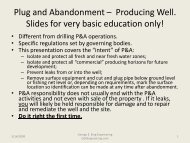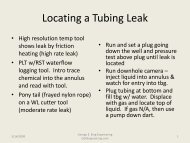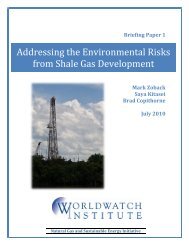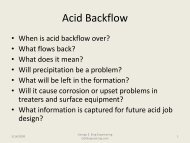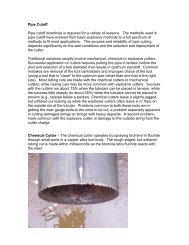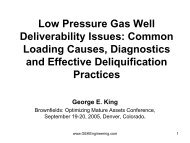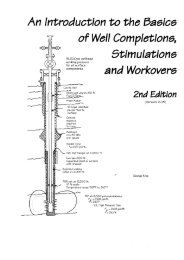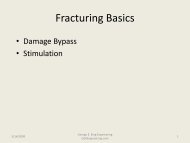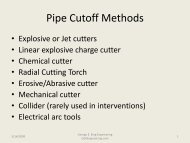quality control checklists - George E King Petroleum Engineering Oil ...
quality control checklists - George E King Petroleum Engineering Oil ...
quality control checklists - George E King Petroleum Engineering Oil ...
Create successful ePaper yourself
Turn your PDF publications into a flip-book with our unique Google optimized e-Paper software.
Quality Control – A Starting Place for<br />
post drilling operations and treatments<br />
The specifics of <strong>quality</strong> <strong>control</strong> necessary to deliver good performance in<br />
any treatments depends upon the knowledge and understanding of the<br />
<strong>control</strong>ling factors for a job and the ability to check the items identified<br />
before the job, during the job and in some cases, after the job.<br />
This list contains work of many industry specialists. It is a list of<br />
suggestions that could form a starting point, but check points will need to<br />
be added and/or removed to fit a job. Always involve knowledgable<br />
specialists in the specific technology and use local experienced field<br />
people as the first resource. Some errors may be found and applications<br />
are never uniform across the industry, thus absolutely no guarantees are<br />
made for accuracy or responsibility.<br />
“QUALITY CONTROL IS WHAT YOU INSPECT, NOT WHAT YOU<br />
EXPECT..........”<br />
(author unknown)<br />
1
Index<br />
Page<br />
Acidizing 3<br />
Acid Fracturing 6<br />
Brines 7<br />
Casing Running 8<br />
Cementing 10<br />
Chemical Treating (non acid) 14<br />
Chrome Pipe Handling<br />
Coiled Tubing 15<br />
Drill Stem Testing 16<br />
Electric Line 21<br />
Filtration 22<br />
Fracturing 24<br />
Gravel Packing 28<br />
Logging 30<br />
<strong>Oil</strong> Base Mud Removal 32<br />
Perforating 33<br />
Tanks 37<br />
Slickline 38<br />
Specialists 41<br />
2
Acidizing<br />
Workover Brief Specifications<br />
____ workover objective clear<br />
____ are sour gas or other liquid, solid, fume or vapor precautions identified to meet<br />
safety and local regulations<br />
Job<br />
____<br />
____<br />
____<br />
____<br />
____<br />
____<br />
____<br />
____<br />
____<br />
____<br />
____<br />
____<br />
____<br />
____<br />
____<br />
____<br />
____<br />
____<br />
____<br />
____<br />
____<br />
____<br />
pad, weather, access, and light adequate for job<br />
acid storage time in unlined steel tanks minimized<br />
acid type and strength as per procedure.<br />
acid strength tested Strength = _______%. Suggest that HF acid blends not be<br />
tested in the field.<br />
acid volume on location is adequate for the job<br />
acid and additives suitable for formation<br />
inj rate and/ max pressure limits known and available to pumper<br />
correct amount and type of corrosion inhibitor added<br />
iron <strong>control</strong> additive used if designed<br />
mutual solvent and/or non-emulsifying agent<br />
antisludge additive used if needed<br />
other additives<br />
additives compatible<br />
preflush vol, type and procedure.<br />
overflush vol, type and procedure.<br />
tubing cleanout (pickle) procedure specified<br />
is acid heating required to <strong>control</strong> tubing contraction, paraffin, thermal fracturing<br />
or acid freezing<br />
load fluid recovery aid (nitrogen, CO 2 , swab, etc).<br />
tool requirements (packers, spot valves, wash tools) met<br />
diverter type and method of removal known<br />
shut-in time minimized unless altered by design or well type<br />
environmental considerations, handling and disposal restrictions addressed<br />
Yard Inspection<br />
____<br />
does batch analysis of acid meet company specifications<br />
Examples:<br />
Strength with 2% of call out strength.<br />
HF content less than 100 ppm in HCl (limestone & limey sandstones)<br />
Chlorinated hydrocarbon content less than 100 ppm.<br />
SO 4 content less than 1500 ppm.<br />
Sulfite (SO 3 ) content less than 100 ppm.<br />
Total dissolved solids less than 15 ppm.<br />
Total iron less than 100 ppm.<br />
____ fluid compatibility check with formation fluids using live and spent acids<br />
with all the additives Is compatibility test fluid representative of field<br />
____ MSDS sheets available for all additives<br />
3
____ additives checked for compatibility<br />
____ acid color is near "white" or clear. Yellow acid indicates iron.<br />
____ transfer lines clean<br />
____ truck tank clean<br />
____ acid strength measured<br />
____ additives added (volumes checked by meter or calibrated measure).<br />
____ ion analysis of fresh water makeup for HCl/HF is compatible with HF.<br />
____ capability to circulate tank Avoid hand held air lance. (Air rolling is permitted)<br />
____ additive batch numbers recorded if necessary<br />
Field Inspection<br />
____<br />
____<br />
____<br />
____<br />
____<br />
____<br />
____<br />
____<br />
____<br />
____<br />
____<br />
____<br />
____<br />
acid tanks containing acid with inhibitor rolled continuously prior to injection<br />
HCl acid strength measured.<br />
What is raw HCl acid color (Yellow indicates iron.) Dark yellow or green/blue<br />
color may be a reason to test iron content of acid prior to use. If inhibitor is<br />
already in acid, a color test may not be possible.<br />
inhibitor present (Inhibitor color is brown, additives may color acid.)<br />
no visible solids suspended in acid. (Filter if needed using polypropylene filter<br />
elements or DE with polish filter.)<br />
obtain copy of loading ticket - this ticket must be on truck to satisfy hazardous<br />
materials transport law.<br />
check size of ball sealers and compare to perforation size (balls should be larger<br />
than the largest possible perforation diameter.<br />
does ball sealers density match the design<br />
check number of balls and schedule for dropping.<br />
correct type and volume mutual solvent<br />
correct type and quantity iron <strong>control</strong><br />
lines clean and flushed<br />
all job recording devices on location and working correctly<br />
Acid Treatment<br />
____<br />
____<br />
____<br />
____<br />
Safety meeting with responsibilities set out clearly.<br />
pressure behavior observed when acid reached formation<br />
pressure response observed when diverter used<br />
job surface injection pressure record obtained<br />
Backflow/Swab<br />
____ surface pressure recorded at specified times after shut-in<br />
____ backflow samples taken if required for returned acid testing.<br />
Equipment Inspections<br />
Tank Inspection<br />
____<br />
____<br />
____<br />
method to circulate tank.<br />
hatch covers available.<br />
tank clean to bare bottom.<br />
4
____<br />
____<br />
tank can be strapped<br />
no deposits of rust or scale.<br />
Pumps<br />
____<br />
____<br />
____<br />
seal materials compatible with acids and additives.<br />
pressure and rate to satisfy job.<br />
lines to circulate acid tank.<br />
On-Site Inspection<br />
____ Safety meeting with responsibilities set out clearly.<br />
__________ acid strength titration or hydrometer check.<br />
____ additives on location.<br />
____ acid volume check.<br />
____ flush volume check.<br />
____ viscosity check to design specs with Fann VG meter.<br />
____ compatibility check with wellbore, pre and post flush fluids<br />
Backflow Examination<br />
____<br />
____<br />
____<br />
____<br />
____<br />
pressure recordings, if needed for PTA or post frac analysis.<br />
solids in backflow<br />
emulsions in backflow<br />
acid strength of backflow by titration (3 samples).<br />
precipitates after standing (May require lab analysis.)<br />
5
Acid Fracturing<br />
Workover Brief Specifications<br />
____ job objectives clear<br />
__________ acid strength<br />
__________ acid volume<br />
__________ acid corrosion inhibitor vol.<br />
__________ acid diverter/fluid loss info.<br />
__________ acid additives specified.<br />
____ additives given per acid volume<br />
__________ preflush volume and type.<br />
__________ after flush volume and type.<br />
____ flush compatibility OK with acid and wellbore fluids<br />
__________ maximum injection rate and pressure.<br />
____ perf balls correct size for perfs Correct ball specific gravity.<br />
Backflow Information<br />
__________ shut-in time (if any)<br />
__________ max backflow rate<br />
__________ initial choke size<br />
____ is a ball catcher required before the choke<br />
__________ final choke setting<br />
__________ lowest rate before running pump.<br />
__________ pH level before turning backflow to system.<br />
____ target viscosity specified for gelled acids<br />
____ is breaker required<br />
____ gelled acid break test<br />
____ is acid friction reducer required<br />
____ viscosity measured on Fann VG meter for all gelled acids<br />
____ is a shear rate specified for all gelled acid viscosity measurements<br />
____ environmental considerations, handling and disposal restrictions<br />
addressed<br />
6
Brines<br />
____ brine is clean and filtered to specification.<br />
____________ record micron rating and beta rating of filter.<br />
____ if brine mixed on location, mixing procedures and order of mixing<br />
followed<br />
____ equivalent circulating density calculated if viscosifier is to be used<br />
____ viscosifier checked with field brine for gelling, speed of hydration<br />
and stability<br />
____ brine density is correct<br />
____ is a density temp correction needed for downhole<br />
____ MSDS sheets available for brine additives<br />
____ brine additives checked for compatibility<br />
____ pH of brine recorded<br />
____ compatibility of brine with additives checked against formation<br />
fluids<br />
____ brine stored in covered tanks<br />
____ analysis on brine provided by supplier (in file)<br />
____ brine checked for compatibility with wellbore fluids<br />
____ crystallization point of specific mixture is above all working<br />
temperatures (including sea floor) along tubulars<br />
____ fluid loss <strong>control</strong> available if needed<br />
____ corrosion inhibitor, bactericide and oxygen scavenger considered<br />
Effect of temp on inhibitors<br />
____ effect of brine/corrosion inhibitor on packer rubber<br />
____ environmental considerations, handling and disposal restrictions<br />
addressed<br />
7
Casing Running<br />
____ Safety meeting with responsibilities set out clearly.<br />
____ casing fill-up schedule followed<br />
__________ max running speed per joint.<br />
____ monitor mud returns for proper casing displacement.<br />
____ check recommended torque and makeup procedure for couplings.<br />
____ joints Identified for stage tools.<br />
____ torque makeup <strong>control</strong>.<br />
____ centralizers positioned as designed.<br />
____ double float.<br />
____ float collar 2 - 3 joints above shoe.<br />
____ use thread lock on float/DV equipment (do not use thread lock on<br />
more than 1full stand).<br />
____ casing packers (if designed).<br />
____ standoff bands (if designed).<br />
____ seal rings (if designed).<br />
____ other equipment as designed.<br />
____ ability to rotate and reciprocate as designed.<br />
____ casing clean and debris free.<br />
Mud Displacement<br />
____ pipe reciprocation.<br />
____ pipe rotation.<br />
__________ max recip. speed to prevent press. surging.<br />
____ rotation 3 to 10 rpm. Torque limit<br />
Deviations less than 60 o<br />
____ Lowest YP and PV without dropping solids<br />
Deviations greater than 60 o<br />
____ YP = 20 to 25<br />
____ spacer required Type, volume<br />
____ condition hole at rates up to cementing rates<br />
____ 95% of hole circulated by circulating caliper (grain, dye, etc)<br />
____ volume and rate of returns verified<br />
____ return fluid flow measurement operational<br />
____ free fall prediction reviewed<br />
Mud Return Operations to Note<br />
8
Spacer arrival and Mud Conditioning<br />
____ color change<br />
____ pH change<br />
____ viscosity change<br />
____ density change<br />
____ Do not over displace. If plug has not bumped when displacement<br />
volume has been pumped, shut down the pump. Avoid a wet shoe<br />
by over displacing less than the volume of the pipe between the float<br />
and the shoe.<br />
____ check for flow back.<br />
____ open casing after bumping top plug.<br />
9
Cementing<br />
Workover Brief Specifications<br />
____ job objectives clear<br />
__________ maximum density to avoid fracturing.<br />
__________ maximum pump pressure to prevent fracturing.<br />
____ lost circulation zones identified from drilling.<br />
__________ wellbore fluid density.<br />
__________ density of mixed slurry.<br />
__________ salt content of brines.<br />
__________ bottom hole cementing temp.<br />
____ maximum fluid loss (1000 psi) specified (at a test temperature), or<br />
use following.<br />
____ 20cc/30 min, prevention of gas channels.<br />
____ 50cc/30 min, liner cementing.<br />
____ 250cc/30 min, casing cementing.<br />
____ 50 to 200cc/30 min, squeeze cement. Depends on experience and<br />
success in an area.<br />
____ amount of Latex additive specified if a squeeze cement job<br />
____ min spaced flow rate for turbulence.<br />
__________ min cement flow rate for turbulence.<br />
____ Change spacers if plug flow is used.<br />
__________ max flow rate for plug flow.<br />
__________ salt content specified<br />
__________ anticipated mix water temp Guidelines on max. or min. temp<br />
__________ silica flour specified temp > 230°F<br />
____ free water 1% or less<br />
__________ cement thickening time for BHCT and BHP.<br />
Test duplicates field conditions.<br />
____ field water used for lab tests<br />
__________ yield of slurry.<br />
__________ gal mix water/sacks.<br />
__________ total cement on site.<br />
__________ total water on site.<br />
__________ well head pressure during displacement.<br />
__________ bottom hole pressure during displacement.<br />
__________ mixing time.<br />
__________ mud displacement volume.<br />
__________ cement free fall rate.<br />
__________ cum. vol. to catch top plug.<br />
__________ cum. vol. to bump top plug.<br />
____ compat. check of cement slurry with spacers and with mud.<br />
____ environmental considerations, handling and disposal restrictions<br />
addressed<br />
____ onsite Q/C tools available (pressurized balance or scales, if needed)<br />
10
Cement Equipment - Yard Check<br />
Check Cement Wiper Plugs<br />
____ no debris in cavity of bottom plug(s). Plug color<br />
____ bottom plug(s) diaphragm undamaged.<br />
____ top plug solid. Color<br />
____ plug loading procedures clear and understood<br />
____ plug holder can hold all plugs.<br />
____ can drop all plugs without opening.<br />
____ plug catcher operation OK.<br />
____ all tanks clean (NO leftover cement or foreign fluids). Open hatch to<br />
check interior for cleanliness.<br />
____ transfer lines clean.<br />
____ check all cementing head valves.<br />
____ If pipe must be rotated - check operation of rotating head.<br />
____ pump unit to include (for each pump), pressure gauge, a pump rate<br />
indicator and a cumulative barrel counter. All instruments must be<br />
accurate and operational. Tanks can be strapped.<br />
____ pressurized fluid balance required.<br />
____ chart recorder for pump pressure.<br />
____ water tight containers for dry and liquid samples.<br />
____ containers to hold slurry samples. All containers must be marked<br />
with proper identification.<br />
____ auxiliary lights to backup truck mounted lights.<br />
____ chart recorder for annulus pressure on squeeze jobs.<br />
____ density recorder on low pressure side<br />
____ density recorder on high pressure side<br />
____ additional working communications device for BP Rep.<br />
Bulk Cement Blending<br />
Bulk Plant Checks<br />
____ recent calibration of scales.<br />
____ verify weight calc.<br />
____ verify each additive identification.<br />
____ count additive sacks for each blend.<br />
____ do not allow partial bags of additives to be added over and above the<br />
design.<br />
____ sufficient additive mixing.<br />
____ sample the dry blended material from each batch.<br />
____ visually inspect each empty tank for cleanliness.<br />
____ test thickening time on each batch with water to be used on the job<br />
____ estimate of pump time<br />
11
Truck Checks and Loading<br />
____ trucks must be empty prior to loading. Check tanks, surge cans and<br />
hoses.<br />
____ When loading lead and tail slurries, label the tanks as to contents.<br />
____ label samples with compartment information.<br />
Random Sampling Checks (when needed)<br />
____ cement origin recorded Same as lot tested for pumpability<br />
____ cement sample (5 gallons or 20 kg) saved<br />
____ cement additives (1 pint or 500cc) saved<br />
____ sample mix water (5 gal in plastic container) saved<br />
Well Location Reblending<br />
____ remix dry blend.<br />
____ visually inspect empty tanks.<br />
____ collect 5 gal samples from each truck tank.<br />
____ measured volume of water on location before mixing.<br />
____ measured volume/weight of cement on location before mixing.<br />
____ volume or weight of additives on location before mixing.<br />
Pre-Job Communication<br />
____ Review slurry and job design with service company representative.<br />
____ Safety meeting with responsibilities set out clearly.<br />
____ Sampling procedures implemented.<br />
Mixing Cement Slurry<br />
____ <strong>control</strong> slurry density with pressurized balance. Mix as close as<br />
possible to designed density. Use pressurized balance every 5<br />
minutes during mixing.<br />
____ paddle speed and cement addition rate OK.<br />
____ check calib. of all density devices. Density measuring equipment<br />
should be located downstream of pump.<br />
____ calib. meters vs tank strap and press gauges vs chart record.<br />
____ understand effects of free fall on surface pressure gauge.<br />
Log of Operations<br />
____ record event times<br />
____ continuous density measurements.<br />
____ mixing or displacement rate.<br />
12
____ mud return rate.<br />
____ wellhead pressure.<br />
____ operation in progress.<br />
____ cum. vol. pumped.<br />
____ pump speed (spm).<br />
____ properly operating pressure recorder.<br />
Top and Bottom Wiper Plugs<br />
____ inspect hollow core on bottom plug.<br />
____ hollow opening is clear.<br />
____ no extra rubber or trash below diaphragm.<br />
____ diaphragm is undamaged.<br />
____ check sequence of plug loading.<br />
____ bottom plug red or yellow and is hollow with a diaphragm.<br />
____ top plug is black and solid.<br />
____ bottom plug will be first plug dropped.<br />
____ plug head operation check. Valves, drop pin retainer and by-pass are<br />
operational.<br />
____ pump spacers ahead of bottom plug.<br />
____ batch mix if possible.<br />
____ recirculating mixers if mixed on-the-fly.<br />
____ save a sample of mix water (5 gal).<br />
____ cease mixing at first sign of air or sharp density drop.<br />
Material balance at end of job.<br />
____ volume of cement on location after job.<br />
____ volume of water on location after job.<br />
____ volume or weight of additives on location after job.<br />
13
Chemical Treating (Non Acid)<br />
Workover Brief Specifications<br />
____ job objectives clear<br />
____ safety considerations for each chemical known and understood<br />
____ do any have exposure limits (vapor, skin contact, etc.)<br />
____ chemical types and volumes.<br />
____ chemical purity or rejection point specified (How to tell if this is the<br />
chemical that was ordered.)<br />
____ injection pressure maximums.<br />
____ soak time/circulation rate.<br />
____ diverting method (if used)<br />
____ effect of solvent on service company equipment (fluorocarbon or<br />
better seals are usually needed).<br />
____ backflow procedures.<br />
____ byproduct <strong>control</strong> (if needed).<br />
____ environmental considerations, handling and disposal restrictions<br />
addressed<br />
Solvent Treating<br />
____ clear reason for running solvent<br />
____ well equipment and pump equipment seals stable to solvents<br />
____ safety meeting with responsibilities set out clearly.<br />
____ environmental considerations, handling and disposal restrictions<br />
addressed<br />
____ spill prevention and reaction issues addressed<br />
_______ o F flash point for solvent<br />
____ flash point meets requirements for area<br />
____ MSDS information available<br />
____ safety equipment for handling<br />
____ compatibility tests with well fluids<br />
____ solvent type/vol for paraffin removal.<br />
____ solvent type/vol for asphaltene removal.<br />
____ solvent type/vol for scale removal.<br />
____ solvent type/vol for oil base mud removal.<br />
____ method for solvent identification (boiling point, analysis, other).<br />
____ spotting procedure to <strong>control</strong> density segregation. (Most oil solvents<br />
are 7 lb/gal or 0.84g/cc or 0.36 psi/ft.)<br />
____ field test of solvent on damage (if possible).<br />
14
Chrome Pipe Handling (data from John Martin, John Alkire, Khalefa Esaklul, Steve Groves and others)<br />
Transport<br />
1. Chrome tubing should be transported on custom racks to minimize<br />
movement and impact during transport.<br />
2. All tubing joints should be separated by non-metallic dividers. The<br />
dividers should preferably be non absorbent (not wood)<br />
3. Non metallic slings should be used for handling the tubing. Steel slings<br />
with non metallic straps that wrap around tubing may be used.<br />
4. Tubing loading and unloading should be witnessed and <strong>control</strong>led by a<br />
designated person.<br />
Inspection and Preparation<br />
1. Rack tubing on the pipe deck one row at a time, ensuring that the joints<br />
do not come in contact with each other or steel supports. Use nonmetallic<br />
slings for handling.<br />
2. Remove the thread protectors using wooden or plastic mallets. Remove<br />
all desiccant packages. Drift all joints using a non-metallic drift from<br />
box to pin. Use driftable protectors if available<br />
3. Avoid hammering or impacts at all costs. The hardness of Chrome<br />
tubing is strictly <strong>control</strong>led; impacts to the pipe can cause localized<br />
hard spots which can be starting points for sulfide stress corrosion<br />
cracking.<br />
4. Blow through the pipe with compressed air to clear away moisture and<br />
loose debris.<br />
5. Clean both threads and thread protectors with a safe, clean solvent (do<br />
not use diesel or other paraffin containing material) and allow threads to<br />
dry.<br />
6. Use a nylon bristle brush to clean the threads if needed (do not use<br />
wire brushes as wire can remove non-galling and anti-corrosion<br />
coatings).<br />
7. Visually inspect pipe body, thread, thread coating and the seal area for<br />
any signs of damage. Repair of minor pipe body damage may be<br />
attempted in the field using approved repair methods. Thread and seal<br />
damage is cause for rejection of the joint. Red-band the rejected joint<br />
and mark the reason for rejection directly on the joint with nonwashable<br />
marker or paint.<br />
8. Mark the start of the threads on the box and pin ends with a precise<br />
mark a few inches long along the pipe body.<br />
9. If the pipe is no to be run immediately, lightly coat the threads of both<br />
pin and box with an approved material (from pipe manufacturer or<br />
supplier). Use a light coating of an API thread dope if no supplier’s<br />
recommendation exists. Use of a thread dope prevents further<br />
inspection of the threads, so a detailed inspection must be done prior to<br />
coating.<br />
15
Running Pipe<br />
SPE 26754: Harris, D., Jaensch, M.: “Recent Advances in the Handling, Makeup,<br />
and Running of CRA Tubulars,” SPE 26754, Offshore European Conf.,<br />
Aberdeen, 7-10 September 1993.<br />
1. Check all running equipment. Pay particular attention to the condition of all<br />
tong dies. Scratches to the pipe body of Chrome tubing promotes stress<br />
corrosion. Dies specially designed for Chrome tubulars should be used. (In<br />
some areas, the "non-marking" dies for the power tongs have been used, but<br />
they didn't grip properly. In these cases, regular dies (very low profile<br />
gripping teeth) that covers most of the circumference of the pipe were used.<br />
This substitution would need o be on a case by case basis.)<br />
2. Provide an impact absorbing covering or matting on the catwalk (rubber,<br />
wood, fiber, etc., have been used) to provide cushion and separation between<br />
the Chrome tubular and the steel panels.<br />
3. Carefully lift the joints to the cat walk, preferably one at a time or a small<br />
group of bundled joints. Avoid impacts of any kind.<br />
4. Avoid dragging the tubing joints if possible. Avoid dragging over steel at all<br />
costs.<br />
5. All thread protectors must be in place while moving.<br />
6. Using a single joint elevator, raise the joint to stab. Dope according to<br />
manufacturer’s or supplier’s specification of the joint being used. Use pipe<br />
dope sparingly. In absence of supplier’s specification, concentrate dope on<br />
the pin and cover very lightly.<br />
7. Always use a stabbing guide. Ensure guide is the correct size for the tubing<br />
and joint design. The guide should cover the upper box shoulder.<br />
8. With a person on the stabbing board, stab slowly and vertically, ensuring that<br />
the box and pin thread start paint marks are lined up. Vertical alignment<br />
during stabbing and the entire makeup operation is critical. Do not rock the<br />
pipe.<br />
9. Make the first 4 or 5 turns by hand using a strap wrench. This ensures proper<br />
alignment of the threads.<br />
10. Apply backup tongs, then using power tongs equipped with a torque limiting<br />
system (e.g., dump valve), make up joints at low speed (5 rpm).<br />
11. Ensure that pickup elevators are snug against the lifting shoulders when<br />
picking up. Set the slips only after the pipe has stopped moving. Slowly<br />
adjust the slips to take the weight of the string.<br />
12. API modified thread dope (which conforms to API Bulletin 5C2) with a friction<br />
factor = 1, should be used in the absence of a recommended dope. Do not<br />
use contaminated dope of any type. Stir the thread dope before use and<br />
protect from contamination during use.<br />
13. From case histories, the running speed of chrome tubulars is about 6 to 10<br />
joints per hour (for a dual, five joints per string per hour).<br />
16
Pulling Pipe<br />
1. The tubing joint make-up analyzer and speed regulator should always<br />
be used when backing out the connection.<br />
2. The joint should not be in tension when backing out, resulting in impact<br />
damage: this can cause a rapid jump-out resulting in impact damage.<br />
The joint will drop slightly when the thread is fully backed out. Do not<br />
rotate more than ¼ turn past this point or thread galling may result. The<br />
pipe should be backed out slowly, initial breakout at 1 to 2 rpm and<br />
increasing to makeup rpm, before slowing as the disengagement point<br />
is reached.<br />
3. Guide the pin out of the box by hand and lift clear. Visual inspection of<br />
the breakout and threads is recommended for the first 20 joints and<br />
then at a lesser frequency.<br />
4. Replace the thread protectors before laying the pipe down or racking<br />
stands. Coat the threads or the protectors before installing the<br />
connectors.<br />
5. The tubing should be cleaned as soon as possible after pulling from the<br />
well and before the stands are covered by other pipe. This is<br />
particularly important when pulling pipe from a corrosive environment.<br />
When using oil based mud, it should be wiped as it comes out of the<br />
hole.<br />
Storage<br />
1. Thoroughly rinse used pipe internally and externally with fresh water<br />
to remove brine packer and completion fluids within 24 hours of<br />
removal from well.<br />
2. Store Chrome pipe inside or under cover as far away from the sea front<br />
as possible (avoid salt sprays). Rack tubulars a minimum of 18-in.<br />
above ground.<br />
3. Rest on non-metallic supports, preferably of non absorbing design (not<br />
wood).<br />
4. Do not mix any type of corrosion resistant pipe with carbon steel pipe.<br />
5. Do not mix weights, grades or sizes of pipe.<br />
6. Never use metal thread protectors. Use closed-end thread protectors<br />
with grease, preferably inhibited, if or when pipe is internally dry.<br />
7. If tubulars are wet or if closed-end thread protectors are<br />
unavailable, chock one end of the pipe rack a minimum of 8-in. to<br />
provide at least a two pct. slope for internal drainage.<br />
8. Use of gel-type desiccants for internal drying is not recommended.<br />
9. Apply storage compound as pipe comes into the storage facility. Mark<br />
date lot was protected. Use regular inspection to provide needed retreatment<br />
frequency.<br />
10. Inspect periodically (10% of the pipe, including threads, every 6<br />
months) and identify and remove bad joints. Mark joint with specific<br />
17
defect and remove from the storage rack. Re-coat with protective<br />
compounds based on local conditions and needs rather than a worldwide<br />
edict.<br />
11. Inspect the integrity of mill-applied external varnish on new<br />
tubulars. Use an atmospheric corrosion inhibitor coating* if in poor<br />
condition or if corrosion is visibly evident.<br />
12. For temporary storage of used pipe, spray the OD with an atmospheric<br />
corrosion inhibitor coating*, inspect periodically and re-apply as<br />
necessary.<br />
13. For extended storage of used pipe, sand blast or wire brush OD clean,<br />
rinse, dry, and apply a varnish-type coating.<br />
*NOTE: Based on work by L. C. Sumbry and M. E. Climer on inhibitor<br />
coatings for sucker rod storage, we recommend use of solvent-base<br />
(naptha or aromatics) petroleum wax type coatings. Examples include:<br />
Rustron Q-20 (Champion Chemicals/Houston, TX), Rust Veto 345 (E. F.<br />
Houghton/Valley Forge, PA), Tretolite Kontrol KP-94 (Petrolite Co.,<br />
Houston, TX), and SOR 344 (Mayco <strong>Oil</strong> Co./Warminster, PA).<br />
Note that in-house tests have been performed only on steel coupons and<br />
effectiveness on 13Cr materials is unknown.<br />
18
Coiled Tubing<br />
Inspection<br />
____ inspect bridges, roads, overhead lines and locations to identify<br />
height or wt. Problems<br />
____ check location (or platform) for space to operate safety and minimize<br />
overhead crane movements over coil.<br />
____ locate underground lines or cables before setting anchors.<br />
____ model job to depth and pump rates and pressures to determine if coil<br />
mechanical safety is met.<br />
CT BOP and Well Control<br />
____ set BOP’s w/ blinds, cutoffs, kill/return spool, slip rams and blinds<br />
(bottom).<br />
____ have BOP’s been fully tested (not just function test)<br />
____ is BOP rated to cut tubing under maximum possible wellhead<br />
pressure<br />
____ on hazardous workovers, are the riser and BOP NACE certified<br />
____ use double blind/shears on top if using comby rams.<br />
____ use annular preventer if using BHA different size than coil.<br />
____ if perforating on live well, an annular diverter may be needed to seal<br />
around new guns.<br />
____ if fluid will circulated, or acid is to be backflowed/jetted mount a Tee<br />
below the BOP stack. The Tee should be equipped with an isolation<br />
valve and rated to NACE standards and press. rated for expected<br />
surface pressure.<br />
____ install added set of manual rams (minimum pipe/slip) below flow Tee.<br />
____ rerun/choke line and kill line should be equipped with two full<br />
opening valves and a choke manifold (or similar device) rated to the<br />
same or higher pressure rating than the ram preventers.<br />
____ where surface pressures above 3000 psi are possible, use a flow<br />
cross instead of a Tee and develop both sides with choke and flow<br />
lines.<br />
____ choke replacement parts on hand<br />
Pre Job<br />
____ safety meeting held and roles/responsibilities defined<br />
____ identify crane operator/coordinator match up<br />
____ identify conditions when jobs should be shut down and who should<br />
shut it down.<br />
____ personnel warned to stay out of crane boom area.<br />
____ establish evacuation routes, meeting areas and responsibilities<br />
____ pressure test coil to max job pressure<br />
19
____ support legs or base suitable for unit and stack<br />
____ stake down return lines / avoid area during backflow<br />
____ avoid equip. placement that blocks evacuation route.<br />
____ chain injector head should be stabilized with a minimum of three<br />
chains or four legs.<br />
____ pickle tubing and flush with water/nitrogen.<br />
CT Job<br />
____ paint or mark tubing with a permanent depth flag about 300 ft from<br />
free end of tubing.<br />
____ running speeds not to exceed 100 ft/minute until the first trip is<br />
made.<br />
____<br />
____ at end of job, flush coil and leave nitrogen charged if CT to be stored.<br />
CT Transport Problem Suggestions<br />
Coiled Tubing units are heavy and tall. Transport to the job site requires<br />
inspection of routes that can accept the CT weights and heights. The<br />
following, adapted from Alex Sas-Jaworsky’s, publications in World <strong>Oil</strong> is a<br />
good starting point for inspections.<br />
Onshore<br />
Route inspection for height and weight limits.<br />
Unit placement at site.<br />
Crane height, lift weight, angle and swing limits.<br />
Buried line and cable location identity.<br />
Hazard potential for site (wind, water, gas, etc.)<br />
Offshore<br />
Platform desk space and load constraints<br />
CT unit placement<br />
Crane weight limits and reach<br />
Class 1, Division 1 and 2 hazard area (API 500B) MMSINC G-239 and G-231.<br />
Hazard potential for site (wind, water, gas, etc.)<br />
20
Drill Stem Tests<br />
Workover Brief Specifications<br />
____ job objectives clear Wellbore sketch Safety considerations Max.<br />
press<br />
____ H 2 S contingency plans if H 2 S present<br />
____ hole/casing problems Cement squeeze/equip in well<br />
____ type of tests (1) oil zone, (2) gas zone, (3) injectivity test, (4) loginject<br />
log, (5) frac.<br />
____ type of test string to be run - (1) size, (2) retrievable packer and<br />
downhole test tools, (3) permanent packer and no downhole test<br />
tools, (4) permanent packer and downhole test tools, (5) surface<br />
readout required, (6) mud line safety valve<br />
____ considerations for H 2 S, CO 2 , temp, pressures, valves, safety joint.<br />
____ sketch of test string showing all components with I.D. and O.D. of<br />
each part, length, type connections and x-overs.<br />
____ reasons why each test tool is being run. (Don't copy old programs.)<br />
____ how will the well be perforated Backup detonating system<br />
____ if well is to be perforated underbalanced, how much underbalance<br />
What type of cushion<br />
____ hydrostatic requirements given if BHP unknown<br />
____ number of tests to be conducted Expected time frame for each test.<br />
____ if testing below 12,000 ft or for gas, serious consideration should be<br />
given to having a special test string. (Not the drillpipe used to drill<br />
the well.) This string must be thoroughly cleaned before use. Metal to<br />
metal seals/threads are necessary.<br />
____ weight required to set the test packer How much is available in the<br />
test string Are correct rubbers on packer for expected conditions,<br />
(temp, oil base mud, etc.). RA pip tag for packer location by gamma<br />
ray<br />
____ enough slip joints in test string to allow for expansion and<br />
contraction effects How many open and closed<br />
____ expected BHP and BHT.<br />
____ time clock spec. (72, 120 hrs, etc.).<br />
____ gauge type spec. Accuracy Resolution Backups<br />
____ downhole shutoff needed for PBA<br />
____ have dimensions of BOP stack been checked with dimensions of<br />
sub-surface test tree (SSTT) to ensure pipe rams will close on slick<br />
joint Possible to close shear rams after disconnecting from SSTT<br />
____ does the BOP stack have set of pipe rams same size as test string<br />
____ is a lubricator valve installed below rig floor to minimize amount of<br />
lubricator on top of surface tree. Top connection match to<br />
lubricator<br />
____ sufficient fittings for downhole and surface piping<br />
21
____ are slings of sufficient length and rating to hold weight of test strings<br />
if needed Are slings of equal length and will pad eyes fit in<br />
elevators<br />
____ how will test string and surface equipment be press tested. To what<br />
pressure<br />
____ separate air supply for burners to ensure rig air not overloaded<br />
Uninterruptible air supply for <strong>control</strong>s<br />
____ flare line set Adjustments for wind<br />
____ what fluid in test string<br />
____ is surface readout equipment available for downhole press/temp<br />
measurements Different wireline/lubricator required than was used<br />
to perf well<br />
____ H 2 S resistant wireline/equip. needed<br />
____ if bottom hole samples are to be taken, have all necessary mercury<br />
handling regulations/procedures been satisfied<br />
____ if permanent packer run without downhole test tools, is swivel<br />
available with a large enough I.D. to allow shifting tool for sliding<br />
sleeve<br />
____ contingency plans for stimulations<br />
____ contingency plans for oil spill<br />
____ how will well be killed after each test is complete<br />
____ how will previous test interval be isolated from zone to be tested<br />
next<br />
____ if tubing conveyed guns are to be used and wire line work is desired<br />
across perfs, then spent guns will need to be dropped off in rat hole<br />
previously drilled to accommodate them.<br />
Job Preliminaries<br />
____ what has the weather trend been in previous years for the test<br />
period How much down time can be expected Have extra weather<br />
forecasts been ordered for test period<br />
____ are necessary sampling containers available<br />
____ has consideration been given to problem of heat from burner if high<br />
flow rates are expected Wind direction Water pump (rig) capacity<br />
for oil burner water shield 1.25 times oil flow rate.<br />
____ have flare permits been obtained.<br />
____ consideration of freezing problems (glycol)<br />
____ procedures for emergency shut in, line leaks, etc.<br />
____ limits set on when to shut in What to do next<br />
____ safety guidelines prepared stating whether well will be perforated at<br />
night, flow periods started only in daylight, etc.<br />
____ adequate lighting for night operation<br />
____ necessary equipment available to isolate zones, including cement<br />
equip. and drill pipe or wireline to run plugs<br />
____ fishing tools for all the test equipment readily available<br />
Wireline/slickline on standby<br />
22
____ in-line sand traps needed<br />
____ hold down equip. adequate<br />
____ equip. cert. for zone 1 operations Flame arresters on engines<br />
____ all meters/gauges calibrated before arrival<br />
Field Tests<br />
____ pretest all surface equipment and cement pump on deck.<br />
____ pretest downhole tools when possible.<br />
____ check press rating of "chick-sans."<br />
____ are hammer-on union pressure ratings consistant<br />
____ is surface piping arranged so that it is possible to flow to: (a) gauge<br />
tank, (b) heater, (c) separator, or (d) directly to either burner<br />
____ drift all strings.<br />
____ safety meeting.<br />
23
Electric Line<br />
24
Filtration<br />
Workover Brief Specifications<br />
____ does filtering system have adequate capacity for rate and pressure<br />
____ all surface lines/hoses flushed<br />
____ tanks really clean<br />
____ filtration needed<br />
__________ DE or Cartridge<br />
____ max rate specified<br />
____ environmental considerations, handling and disposal restrictions<br />
addressed<br />
DE Filtration<br />
____ is DE press large enough to filter fluid at the required rate<br />
____ enough DE material on location<br />
____ filter bed addition possible<br />
____ 2 micron (or less), beta = 1000, guard filter down-stream<br />
____ can DE be backflushed with water and purged with air.<br />
Cartridge Filtration<br />
____ job objectives clear<br />
____ housing rated for location pressure<br />
____ flow diverter in housing<br />
____ valve at bottom of dirty fluid chamber<br />
____ must be possible to measure press differential<br />
__________ cartridge micron rating at beta = 1000 (Unless otherwise<br />
specified in brief.)<br />
____ correct cartridge for the job (polypropylene for filtering acid. Do not<br />
use resin coated cartridges)<br />
__________ number of these cartridges on location (Are there enough<br />
cartridges to do the job)<br />
____ cartridges fit housing (dia. & length)<br />
____ changeable without shutting down<br />
____ 50 psi press. minimum to filter inlet<br />
Cartridge Changeout<br />
____ change at 35 psi max. differential.<br />
____ pressure bled off<br />
____ dirty fluid drained<br />
____ REPLACE ALL ELEMENTS.<br />
____ elements sealed<br />
____ gaskets in place<br />
25
____ air bled off as pressure slowly applied<br />
Filter Condition<br />
__________ visibly dirty<br />
__________ crushed<br />
__________ outer body broken at any place<br />
26
Fracturing (Proppant)<br />
Workover Brief Specification<br />
____ job objectives clear<br />
____ working headset to the company man for all jobs. This must be<br />
worked out with the service company in advance.<br />
____ prepad/pad/minifrac volumes specified in units to be used by the frac<br />
van.<br />
____ frac fluid total volumes specified. Make sure that the design volumes<br />
on location are usable volumes at the design pump rates. Sufficient<br />
tank reserves included to avoid losing pump prime.<br />
____ additive compatibility at weather conditions considered<br />
__________ total proppant specified.<br />
____ proppant meets <strong>quality</strong> specifications<br />
__________ size proppant specified.<br />
__________ type proppant specified (Brady, Ottawa, ISP, bauxite, etc.)<br />
____ pumping/loading/ramping schedule clear and understandable.<br />
____ minimum pump capacity (HHP) specified.<br />
____ all additives and method of addition specified.<br />
____ rheology testing outlined for both lab and field All tests must use<br />
representative fluids with samples for lots to used for the job.<br />
____ break time at temperature known<br />
____ will field sample be collected for break time test<br />
____ gelled fluids compatible with wellbore fluids<br />
____ crosslinker type specified<br />
____ extra crosslinker on location (Job must be shut down when<br />
crosslinker supply is gone).<br />
____ breaker incorporated in design.<br />
____ method for monitoring breaker addition is included.<br />
__________ pH of base gel before crosslinking.<br />
__________ pH of completed frac fluid.<br />
____ tubular pressure limit specified.<br />
____ clean string or use work string.<br />
____ tree saver<br />
____ maximum annulus pressure specified<br />
____ water tight sample containers specified<br />
____ plan for what to do if one pump goes down. What to do if blender<br />
goes down<br />
____ type of resin coated sand specified<br />
____ % resin on sand specified What to do if a sand conveyor goes<br />
down<br />
____ contingency on screen-out discussed<br />
Pre-Frac (Field and Yard) Inspection<br />
27
____ densometers in line on each blender and working correctly<br />
__________ when was last time densometers were calibrated<br />
____ pump rate/vol verified with tank readings<br />
____ tanks clean (visually inspected to bottom). Bactericide added before<br />
filling tanks.<br />
____ no broken or partial additive bags.<br />
____ proppant hauling tanks clean by visual inspection.<br />
____ proppant size check.<br />
____ check frac fluid break time with water bath.<br />
____ unions/connections compatible.<br />
____ water source is as specified.<br />
Field Inspection<br />
____ sufficient usable additives and fluid volumes on location to do job<br />
mix frac fluid with water/oil to be used on the job.<br />
____ record viscosity of gel. Does it meet minimum viscosity based on<br />
lb/1000 gal. as measured in lab<br />
____ record pH and visual description (ropy, smooth, colors, fisheyes,<br />
etc.)<br />
____ save 1 pint or 500 cc frac fluid sample without breaker for<br />
comparison.<br />
____ save 1 pint or 500 cc frac fluid sample with breaker for comparison.<br />
____ safety meeting with responsibilities set out clearly.<br />
____ headset working<br />
____ supply valves operating and not leaking.<br />
____ proppant transfer equip. operation is operational and clean.<br />
____ proppant transfer machinery calibrated (copy to file).<br />
____ estimate quantities of all additives/fluids/proppant on location.<br />
____ same additive batch #'s used in lab<br />
____ copy of loading ticket.<br />
____ service company has copy of MSDS sheets in their file on location<br />
for each chemical.<br />
____ field sieve analysis of proppant OK<br />
____ flow rate meters calibrated and working.<br />
____ additive addition devices working and accurate<br />
____ all instrumentation functional.<br />
____ all valves and pop-offs installed.<br />
____ use "Y" type frac head rather than a "T" head to minimize proppant<br />
damage.<br />
____ if a computer ramping blender is used, do trial model run to check<br />
closeness with design.<br />
____ flush all lines and pumps.<br />
____ surface lines pressure tested to maximum allowable pressure plus a<br />
safety factor.<br />
28
Frac Fluids<br />
____ all water clean and from source specified in the brief.<br />
____ is a water heater required to prevent tubing/packer movement<br />
____ bactericide added (must be maintained in polymer solutions in warm<br />
weather).<br />
____ filtered<br />
____ mix a sample of all polymer fluids prior to start of job.<br />
____ any condensates and oils to be used are clean (filtered just before<br />
use), unweathered and same as used in testing.<br />
____ mix a sample of gelled oil fluid if used.<br />
____ keep a 500 cc or 1 pint frac fluid sample without breaker.<br />
____ keep a 500 cc or 1 pint frac fluid sample with breaker.<br />
____ breaker and crosslinker schedules on location Check delay x-<br />
linking.<br />
Proppant<br />
____ proppant meets acceptable ranges for size and cleanliness.<br />
____ proppant sample collected. Collect multiple samples from the belt or<br />
proppant handling system and combine into a single sample for each<br />
individual proppant size.<br />
____ proppant bins identified for size, type and coating.<br />
Fracturing Operations<br />
____ dilute breakers in liquid form and meter into frac fluid on-the-fly.<br />
____ monitor breaker addition on recording chart.<br />
____ when well is on strong vacuum, cut flush short in order to leave<br />
perfs covered with sand.<br />
____ when pumping resin coated sand tail-in where wells go on vacuum,<br />
include activator in flush water to insure resin bonding.<br />
____ monitor premixed frac gels for pH and viscosity (bacteria <strong>control</strong> is<br />
critical in warm weather).<br />
____ monitor cross-link times in oil gels.<br />
____ popoffs installed and braidenhead open<br />
____ tree saver installed.<br />
____ annulus pressured.<br />
____ pressure test all equipment.<br />
____ standby blender hooked in and ready.<br />
____ save samples of on-the-fly mixed gels.<br />
After the Frac<br />
____ collect shut-in information as specified.<br />
____ check proppant/additive storage to get true volumes used.<br />
29
____ inventory (strap) and record volumes in all tanks.<br />
____ follow backflow procedure.<br />
____ samples collected from backflow.<br />
30
Gravel Packing<br />
Workover Brief Specifications<br />
____ job objectives clear<br />
____ wellbore sketch with all equipment and dimensions<br />
____ gravel size specified<br />
____ gravel volumes spec.<br />
____ gravel type (ceramic, resin coat, etc)<br />
____ preflush fluid specifications.<br />
____ main packing fluid spec.<br />
____ acidizing/acid prepack design<br />
____ packer type spec.<br />
____ wash pipe OD/ID specified<br />
____ screen OD, ID, gauge opening spec.<br />
____ flush joint liners used in narrow (
____ jars above GP assembly.<br />
Fluid Tests<br />
____ well circulation fluid clean after pickle<br />
____ gravel fall rate of 1/8" (or less) in 5 min<br />
____ base carrier fluid clean.<br />
____ gelled fluid sheared and filtered (10 micron at beta = 100).<br />
____ ungelled fluids filtered to 2 micron or less (beta = 1000).<br />
____ field viscosity check<br />
____ chemical additives as scheduled.<br />
Samples (if called for)<br />
____ base fluid sample (1 quart).<br />
____ dry polymer sample (1/4 lb).<br />
____ other chemicals in fluid (50 cc each).<br />
____ gravel (1 quart).<br />
____ gelled fluid (1 quart).<br />
Gravel Packing Operations<br />
____ Safety meeting with responsibilities set out clearly.<br />
____ makeup gravel pack assembly.<br />
____ drift all screens, nipples and blank pipe with Teflon rabbit<br />
____ pipe clean inside and outside.<br />
____ use pipe dope sparingly - dope pins only, not boxes. Wipe off excess<br />
dope from outside of joint.<br />
____ locate sump packer.<br />
____ record pickup and slackoff weight prior to stinging into sump packer.<br />
____ test circulating positions when using multi-position packer and mark<br />
locations on string.<br />
____ establish circulation in lower position, mark pipe, and record<br />
pressure to break circulation.<br />
____ locate reverse position, mark pipe 5 ft above rotary table.<br />
____ break circulation and note free returns.<br />
____ pickle the screen assembly. Use soak or slow circulation.<br />
____ injection tests prior to gravel mix.<br />
32
Logging - Open Hole/Cased Hole<br />
Workover Brief<br />
____ job objectives clear Wellbore schematic<br />
____ purpose specified for each log<br />
____ type/size of tools and logs to be run.<br />
____ wellbore fluid compatible with the logs<br />
____ size of tools OK for hole Is hole OK<br />
____ intervals specified for each log. Can the deepest depth to be logged<br />
be reached with the highest sensor on the string<br />
____ original KB measurement known and referenced to log depths<br />
____ order in which logs to be run<br />
____ indicate possible log scales.<br />
____ lithology settings for FDC-CNL<br />
____ identify correlation log if used.<br />
____ approximate BHT referenced<br />
____ tool temp/press limits (max temp for tools at least 20oF above<br />
estimated BHT)<br />
____ offset log available for reference.<br />
____ wellhead pressure referenced/pressure <strong>control</strong> equipment required.<br />
Specify type and pressure rating.<br />
____ is well sour or sweet<br />
____ define logging speed.<br />
Log Heading Information<br />
____ Well name, company and location<br />
____ API number<br />
____ date of log<br />
____ log interval, casing data, KB reference.<br />
____ allowable error constants for each type equip.<br />
____ mud or fluid type in wellbore and surface circulating mud<br />
temperature.<br />
____ bottom hole temperature<br />
____ truck number, service company personnel and service company yard<br />
location.<br />
____ elapsed time for each run.<br />
____ bit sizes and changes.<br />
____ log column identification and units.<br />
____ service company log equipment type and serial number.<br />
____ scale and scale changes.<br />
____ deviation through logged zone.<br />
Operation<br />
____ record both shop and field calibration values of tools on logs.<br />
____ tool sketch (OD's, length)<br />
____ line condition/size/max pull<br />
33
____ date line last marked<br />
____ date of last reheading and service after heading<br />
____ cable log book checked<br />
____ record location and number of any splices on cable section in well.<br />
____ caliper check in the surface pipe.<br />
____ log reading check in "standard zone"<br />
____ collect freshly circulated mud sample for resistivity measurement.<br />
____ run filtration test on mud sample and record filtrate resistivity.<br />
____ BHT measured on each run.<br />
____ save samples from DSTs.<br />
____ cable stretch corrections utilized.<br />
____ repeat sections identified<br />
____ log <strong>quality</strong> met<br />
34
<strong>Oil</strong> Base Mud Removal<br />
____ removal tests run on a representative sample of oil base mud with<br />
the cuttings. Do NOT use a laboratory sample.<br />
Solvent Removal of OBM<br />
____ circulate 10 gal xylene/ft of net pay into zone. Slowly inject into zone.<br />
____ soak minimum of 4 hours. Precautions must be taken to keep xylene<br />
from floating up if water is in the hole (trap under a packer or plug or<br />
use a selective injection device).<br />
____ backflow xylene to surface or displace into reservoir (backflow is<br />
better).<br />
____ treat cuttings with HCl or HCl/HF and a mutual solvent.<br />
____ backflow if possible.<br />
Dispersant Removal of OBM<br />
____ determine dispersant chemical need on representative field mud<br />
sample.<br />
____ circulate package to zone and inject.<br />
____ shut-in specified time.<br />
____ backflow if possible.<br />
35
Perforating<br />
Workover Brief Specifications<br />
____ job objectives clear<br />
____ interval and depth to be perforated<br />
____ type (DP or BH) and size of charge specified<br />
____ temperature rated charge required<br />
____ gun/seals rated for hostile environment Confirm pressure rating of<br />
gun systems (expendables and HSC).<br />
____ depth <strong>control</strong> method (and tolerance) specified<br />
____ logging tools identified<br />
____ size and type of gun/carrier specified. Confirm maximum gun size<br />
after firing.<br />
____ phasing specified.<br />
____ shot density.<br />
____ TCP or wireline.<br />
_____ flow rate or volume to clean perfs. (1/8 bbl/perf positive flow is min.<br />
recommended flow vol.) Best flow rate is as fast as possible.<br />
__________ which log is being tied into<br />
__________ date of log being tied into<br />
__________ perforating company.<br />
__________ charge manufacturer and charge id number or size.<br />
__________ will a full lubricator be needed (what pressures), field pressure<br />
test required at what pressure<br />
____ hole displaced to filtered fluid<br />
____ casing scraper run while displacing fluid<br />
____ casing sub depth known (are expected).<br />
____ hole restrictions, if any, older perforations, drill-out bridge plugs, etc.<br />
Tubing Conveyed Perforating<br />
____ type of firing system (bar drop, pressure, elect. line, etc.)<br />
____ depth <strong>control</strong> proc. OK (correlation log specified).<br />
____ surface press to fire if press activated.<br />
____ type of backup firing system<br />
____ underbalance specified by press. and hydrostatic<br />
____ bottom shot detector (if required).<br />
____ Gun release (if gun to be dropped).<br />
____ type of release<br />
____ tool requirements<br />
____ after firing gun size OK<br />
____ circulation vent.<br />
____ RA pip tag needed<br />
____ 100 hour charge life at BHT<br />
____ log rerun after tubing spaced and well head flanged<br />
Wireline Conveyed Perforating<br />
36
____ gauge ring run<br />
____ overbalance considered (if casing gun run by wireline).<br />
____ underbalance for thru-tubing guns Underbalance in terms of fluid<br />
head.<br />
____ lubricator length and id<br />
____ H 2 S protected wireline needed<br />
____ 24 hr min. charge life at BHT<br />
____ sinker bars needed<br />
Before Firing Inspections<br />
Gun Body Inspection<br />
Port Plug Gun<br />
____ right phasing and spf.<br />
____ no splits, cracks, or corroded areas that could leak.<br />
____ no excessive swelling (limit 0.1" OD increase in tight clearance wells<br />
and 0.2" OD increase maximum).<br />
____ welded areas smooth and unpitted (eliminate leaks).<br />
____ no paint or debris on gun body (hides flaws). (Advise service<br />
company before job).<br />
____ port plug threads undamaged (limits blown plugs).<br />
____ minimum 3 threads on plugs.<br />
____ port plug sealing areas are smooth (seals better).<br />
____ port plug holes are round and diameter within 0.020" of specification.<br />
____ recess opposite port is clear.<br />
____ undamaged threads/seal areas on ends.<br />
____ gun body is clean inside.<br />
Scallop Gun<br />
____ correct phasing and spf<br />
__________ gun body weight.<br />
__________ high or low pressure gun (guns for low pressure wells<br />
are heavier wall).<br />
____ new seals on gun-to-gun connectors (tandems).<br />
____ no paint or deposits.<br />
Charge/Detonating Cord/Detonating Cap<br />
Charge<br />
__________ make, Q/C and charge part number.<br />
__________ date of manufacture of charge.<br />
37
__________ were the charges sealed in a moisture proof package. If not<br />
sealed, charges older than 3 years in a dry climate and 6 months in a<br />
moist climate should not be used.<br />
____ DP charges should be powdered metal liners (no seam in copper<br />
liner).<br />
____ no cracks, chips, corrosion or scratches on liner.<br />
Alignment Equipment<br />
____ correct alignment strip carrier for charge.<br />
____ position screws/pins used.<br />
____ correct alignment washer/sleeve, and port plug for gun/charge<br />
combination.<br />
____ verify top shot placement.<br />
____ are sample perforation charges to be save until after the job<br />
____ recent card gap test on file for PYX charges<br />
Detonating Cord<br />
__________ explosive grain rating of cord.<br />
____ correct type of detonating cord for charge.<br />
__________ date of manufacturer of detonating cord. (< than 1 year old.<br />
Detonating Cap<br />
____ a resistor, fluid desensitized cap or safe detonating system must be<br />
used on wireline guns.<br />
__________ part number or name of cap.<br />
____ a booster cap must be used at gun joints when joining guns. confirm<br />
reliable explosion transfer mechanism.)<br />
____ cap at bottom of most E-line fired guns.<br />
Loading Operation/Tools<br />
____ blunt nose positioning tool used in loading port plug guns. Use right<br />
size positioning tool (never use a screw driver).<br />
____ port plug seal evenly extruded.<br />
____ correct charge securing clips in a scallop gun<br />
____ avoid sharp bends and tight spots with detonating cord.<br />
____ pressure test gun at shop with internal air pressure.<br />
____ If plug loss is high, check hole size and tightening procedure.<br />
____ det. cord positioned against back of charge<br />
____ strip centered in gun<br />
____ verify top shot location<br />
____ strip locked in place<br />
____ mark empty gun sections.<br />
)<br />
38
Safety/Documentation/Final Check<br />
____ Safety meeting with responsibilities set out clearly.<br />
____ check CCL operation with steel bar. Before connection to gun.<br />
____ sketch of gun showing distance from CCL to top and bottom shot.<br />
__________ Record size and shape of fishing neck.<br />
__________ Record maximum size of gun/equipment.<br />
____ radios off. (avoid operation near transmission lines, microwave<br />
towers). Welding equipment off.<br />
____ ground strap to wellhead. Monitor stray voltages.<br />
____ safety device on unit in safe position before arming gun.<br />
____ non critical personnel clear area before cap is installed.<br />
____ electrical blasting cap connection to be made before connection of<br />
cap to detonating cord. (Not witnessed, only service company to<br />
confirm.)<br />
Depth Control<br />
____ depth <strong>control</strong> accuracy known<br />
____ measurement wheel calibration <strong>control</strong> is accurate.<br />
____ distance from CCL/GR to first shot is known<br />
____ correction of open hole to cased hole gamma-ray and/or collars<br />
____ adjust depths for kelly bushing<br />
____ log correlation adequate RA tag found<br />
____ review depth <strong>control</strong> procedure<br />
____ cable creep considered<br />
After Firing<br />
____ CCL check of perforated interval<br />
____ service company checks gun for complete firing.<br />
____ debris in gun is pea to dime size (no whole charge cases).<br />
____ holes in scallops or port plugs are centered.<br />
____ holes are round.<br />
____ no solid copper debris in gun holes.<br />
____ number and location of blown plugs recorded.<br />
____ confirm CCL depth offsets.<br />
____ note location of bad shots.<br />
____ If a series of bad shots (more than 10% of total) is found - is<br />
reperforating necessary<br />
39
Tank Inspections<br />
Lined and Unlined Tanks<br />
____ are the volume measurement charts correct for the type and size<br />
tank you are using<br />
____ can tank be mixed or circulated<br />
____ liner material OK with fluids being used<br />
____ fluid inhibited (in unlined tank)<br />
____ corrosion inhibitor life known and inhibitor replenishment schedule<br />
OK<br />
____ all hatches have cover<br />
____ is gauging possible without opening tank if using hazardous fluids<br />
____ compatible unions on outlets to available hoses and other tanks to<br />
be coupled<br />
____ H 2 S service, waste service and salt water holding tanks not used<br />
(scale & deposits)<br />
Lined and Unlined Tanks – empty<br />
____ can bottom be observed and is it clean<br />
____ condition of walls/bottom (scale, rust, mud, clean)<br />
____ outlet and sample valve operation OK<br />
Lined and Unlined Tanks – filled<br />
____ number of compartments<br />
____ record material type and height from top of tank to surface of<br />
material in each compartment<br />
____ sample each compartment (if needed)<br />
____ valves seating without leaking<br />
40
Wireline<br />
Slickline<br />
Wire Inspection<br />
____ Is a regular wire inspection program part of the service company’s<br />
culture<br />
____ wire can meet torsion (turn testing) criteria<br />
wire size new wire In use<br />
turns to break turns to break, minimum<br />
0.072” (1.68mm) 29<br />
0.082” (1.83 mm) 26<br />
0.092” (2.08 mm) 23<br />
0.108” (2.67 mm) 20<br />
0.125” (2.74 mm) 22 18<br />
____ torsion break of wire is square (reject if break is jagged)<br />
____ if use is for sweet wells - wire has not been used in an H 2 S well.<br />
____ if use is for sour well, wire stays in inhibitor pickling solution<br />
____ wire micrometer measurement is within tolerance<br />
wire size new minimum In use minimum<br />
0.072” (1.68mm)<br />
0.082” (1.83 mm)<br />
0.092” (2.08 mm)<br />
0.108” (2.67 mm)<br />
0.125” (2.74 mm)<br />
____ sufficient wire on spool to work to bottom plus at least 500 ft<br />
BOP, lubricator and stuffing box<br />
____ BOP’s have been tested to seal around wire in use at maximum well<br />
pressure.<br />
____ on hazardous workovers, are the lubricator and BOP NACE certified<br />
____ is lubricator tested for the maximum possible well pressure<br />
____ is the stuffing box rebuilt before each major job<br />
____ were the rubbers replaced when the stuffing box was rebuilt<br />
____ were the flow tubes checked for wear and proper diameter for wire<br />
____ does the grease injector have a working pressure <strong>control</strong><br />
____ are the grease injector lines in good shape<br />
41
____ does the grease in use in the stuffing box meet criteria for the<br />
conditions of the job<br />
Grease Injector Evaluation<br />
____ Blowing grease in the air - the rubber is worn out.<br />
____ Losing grease in the well - the flow tubes are too big or worn; or the<br />
braided line is worn - either way, there is too much clearance.<br />
____ The number of tubes depends on the pressure. The bottom flow tube<br />
needs to be very close to the diameter of the braided line.<br />
____ When grease use is high (over 10 lb/day) the operator may simply be<br />
pumping too much grease - way more than is needed for a seal.<br />
____ Greases comes in different viscosities, formulated for pressure and<br />
temperature combinations .<br />
____ If simply hanging gauges off in the well on the braided cable during a<br />
job, do not pump grease - just tighten up on the rubbers.<br />
____ Some greases thicken and/or emulsify with well or injected fluids,<br />
creating severe formation damage.<br />
Tools<br />
____ workspace clean and tools in good repair<br />
____ wellhead connection flange or coupling is known and wireline unit<br />
has a suitable connector.<br />
____ retrieval tools have sharp shoulders on catch dogs.<br />
____ oil jars rebuilt (if needed)<br />
____ selection of jars, stem, and running and pulling tools adequate for<br />
the job<br />
____ are a variety of overshots available for fishing operations<br />
____ roller stem available for highly deviated wells (>50 degrees)<br />
Pre Job<br />
____ safety meeting held and roles/responsibilities defined<br />
____ spill avoidance criteria met<br />
____ identify conditions when jobs should be shut down and who should<br />
shut it down.<br />
____ personnel warned to stay out of crane boom area.<br />
____ establish evacuation routes, meeting areas and responsibilities<br />
____ sheave connections to wellhead meet requirements of safety.<br />
____ avoid equipment placement that blocks evacuation route.<br />
____ ground strap is used where needed<br />
____ stock of shear pins of various materials adequate for the job<br />
____ wire drum drive in good repair Brake OK<br />
42
____ does the unit have some type of adjustable hydraulic <strong>control</strong> on<br />
drum drive<br />
Job<br />
____ well schematic available with all string dimensions, dog legs,<br />
deviations and restrictions labeled<br />
____ all BHA tools measured with recorded diameters, lengths and thread<br />
patterns of each component of the BHA<br />
____ measurement of collapsed and extended spang jars<br />
____ paint or mark wire with a permanent depth flag about 300 ft from free<br />
end of wire.<br />
____ running speeds not to exceed 500 ft/minute until the first trip is<br />
made.<br />
____ drag measurements made at regular intervals<br />
____ all plug pulling operations have proper equalization tools<br />
Fishing<br />
____ well schematic available with all string dimensions, dog legs,<br />
deviations and restrictions labeled<br />
____ all information on measurements, identity and location of fish<br />
available to operator<br />
____ wire torsion test done before fishing rig-up<br />
____ all fishing tools have a release mechanism or a plan to retrieve wire<br />
when the tools are stuck<br />
____ all catch tool edges are sharp (not severely rounded)<br />
____ lubricator is long enough to contain tool and fish<br />
____ wireline drag readings recorded at several places in well<br />
____ maximum time to jar before stripping wire (100 ft) and re-heading is<br />
one hour<br />
43
Selected BP Specialists – note: this is in draft status, it will change to<br />
reflect the specialists listed in WVA<br />
See WVA website for a complete and updated list of specialists<br />
Well Completion - General –<br />
Paul Adair<br />
Mary Endacott<br />
Dan Gibson<br />
<strong>George</strong> E. <strong>King</strong><br />
Acidizing and Chemical Treating<br />
Walt Lamb<br />
Phil Smith<br />
<strong>George</strong> E. <strong>King</strong><br />
Artificial Lift -<br />
Henry Nickens<br />
Tony Liao<br />
Cementing -<br />
Coiled Tubing -<br />
Rodney Stephens<br />
Charles Leslie<br />
Charlie Michel<br />
Corrosion -<br />
John Martin<br />
John Alkire<br />
KC Lunden<br />
Steve Groves<br />
Downhole Tools -<br />
Steve Ferris<br />
Dan Gibson<br />
Rodney Stephens<br />
Warren Winters<br />
Charlie Michel<br />
Drilling Muds –<br />
Emulsions, Foams, Froths, Dispersions (Production Problems)<br />
<strong>George</strong> E. <strong>King</strong><br />
44
Fracturing<br />
Mark Glover<br />
<strong>George</strong> Turk<br />
Heading Problems<br />
Henry Nickens<br />
Tony Liao<br />
Horizontal Well Completions/Stimulation<br />
Walt Lamb<br />
David Birse<br />
Warren Winters<br />
<strong>George</strong> E. <strong>King</strong><br />
Kill Fluids -<br />
<strong>George</strong> E. <strong>King</strong><br />
Paraffins/Asphaltenes -<br />
<strong>George</strong> E. <strong>King</strong><br />
Perforating -<br />
Steve Wilson<br />
Jack McAnear<br />
Phil S. Smith<br />
<strong>George</strong> E. <strong>King</strong><br />
Explosives – general<br />
<strong>George</strong> E. <strong>King</strong><br />
Sand Control<br />
John Gilchrist<br />
Fraser Elliott<br />
Ed Park<br />
Dave Tiffin<br />
Ian Palmer<br />
<strong>George</strong> E. <strong>King</strong><br />
Scale -<br />
Ian Collins<br />
Laurance Cowie<br />
Subsurface Safety Valves -<br />
Mary Endacott<br />
<strong>George</strong> E. <strong>King</strong><br />
45
Tubular Goods -<br />
Phil Pattillo<br />
Steve Morey<br />
Water Control -<br />
Kate Bell<br />
Dan Borling<br />
Wireline/Slickline<br />
Steve Farris<br />
Charlie Michel<br />
Charlie Leslie<br />
46



